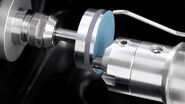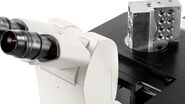About the eBook
Key Learnings:
- Effective sample preparation in electron microscopy (EM) requires careful planning based on the final research objectives and goals.
- Proper budget allocation for sample preparation equipment is crucial to ensure high-quality results.
- Attention to small equipment and details, such as humidity and temperature control, can significantly impact sample quality.
- Array Tomography is particularly valuable for studying complex biological structures and can save time in specimen preparation, especially for correlative light and electron microscopy (CLEM) studies.
The Role of Sample Preparation
Mastering the art of EM is a complex endeavor that resides at the crossroads of biology, chemistry, and physics, presenting you with a myriad of complex concepts to unravel. Moreover, the sheer diversity of EM applications is mind-boggling, and the path to prepare each different sample is just as varied. Every sample you encounter is unique and demands individualized treatment to ensure high sample quality.
Pre-Preparation Considerations
Understanding your scientific goal is paramount in streamlining EM sample preparation workflow for biological applications. Careful planning and considering the final objective are crucial, as these factors will significantly influence how you prepare your samples. This includes whether correlation with light microscopy will be required for technical orientation or targeting studies. Consideration of factors such as the preservation of antigenicity, spatial context, and the need to retrieve fluorescence is essential. Different outcomes require different workflows, involving different equipment and skill sets, all contributing to sample quality.
Sample Handling and Preparation
Sample handling and preparation in EM are equally crucial for ensuring sample quality. Without good sample preparation, even the most advanced electron microscope may produce misleading or inaccurate results. Skillful manual handling of samples is vital, and practice, especially with "dummy" samples, is key to improving coordination and dexterity. Practicing sample handling can significantly improve the efficiency and accuracy of the workflow.
Case Study: High-Resolution Array Tomography
In a case study focusing on high-resolution array tomography, automated serial sectioning is highlighted as a method for achieving a high section density on the carrier substrate. This automation enhances the workflow for Biological Sample Preparation for High-Resolution Electron Microscopy. The high section quality preserved by the elimination of artifacts that may occur during manual section ribbon collection is crucial for obtaining accurate and high-resolution data, particularly in EM sample preparation.
Conclusion
In conclusion, the eBook provides essential insights into EM sample preparation, emphasizing the need for careful planning, budget allocation, and continuous skill development to streamline EM sample preparation workflow for biological applications. It showcases how advanced techniques, such as array tomography combined with automation, can revolutionize the field, enabling high-resolution imaging and expanding the horizons of electron microscopy. Cryo-electron and high-resolution EM are at the forefront of modern research, and achieving the highest sample quality is essential for uncovering valuable insights in biological applications.





